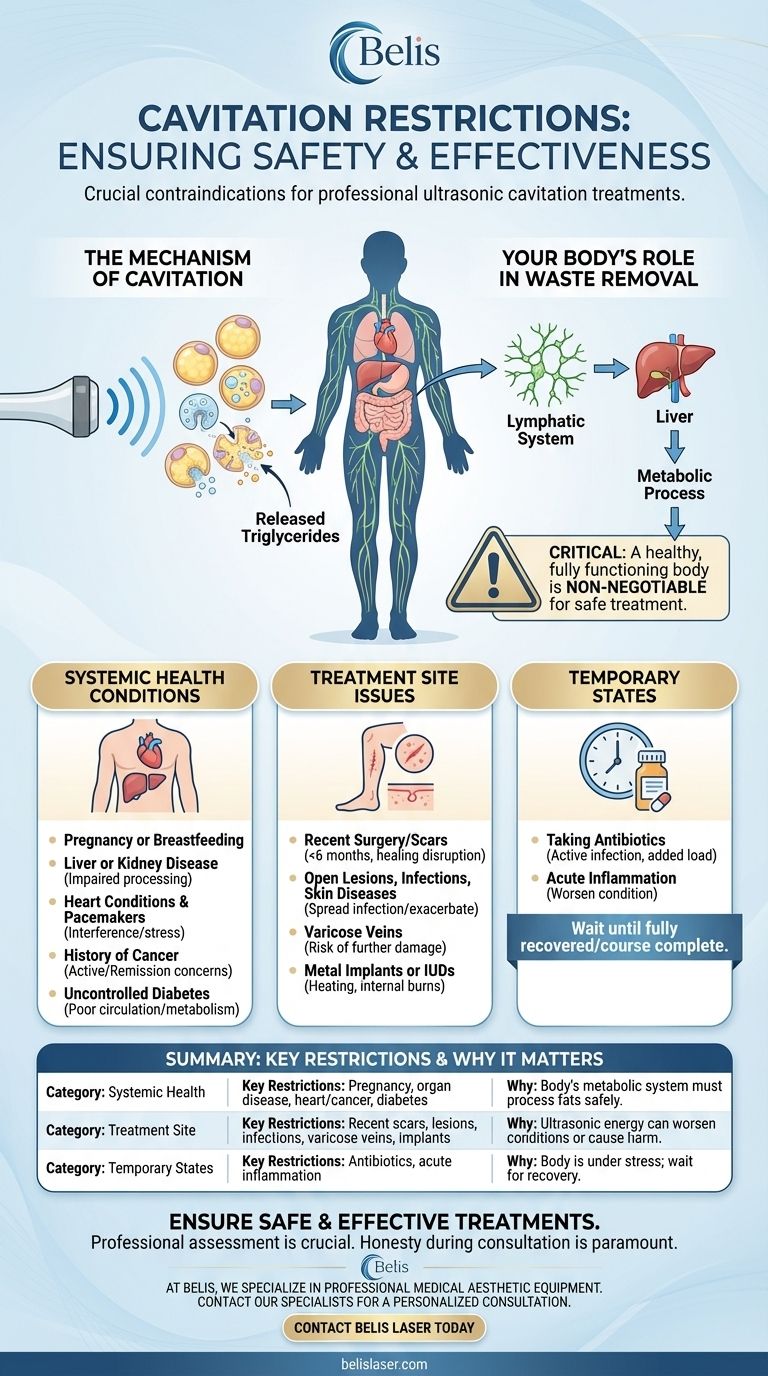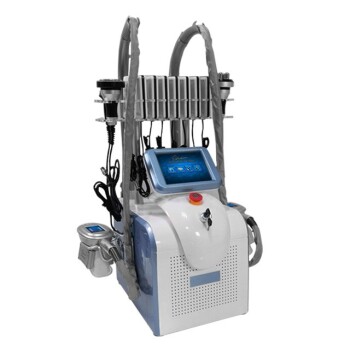To ensure safety and effectiveness, ultrasonic cavitation has several key restrictions. The procedure is contraindicated if you have recent scars or have had surgery within the last six months, are currently taking antibiotics, or have specific medical conditions. It's also crucial to avoid treating areas with open lesions, skin diseases, infections, inflammation, or varicose veins.
The core principle behind these restrictions is simple: ultrasonic cavitation relies on your body's natural metabolic and lymphatic systems to process and eliminate the broken-down fat. Any condition that compromises these systems or the integrity of the skin in the treatment area makes the procedure unsafe and potentially ineffective.

Why These Restrictions Are Critical
To understand the contraindications, you must first understand how the treatment works. It is not a passive process; it initiates a biological cascade that your body must complete.
The Mechanism of Cavitation
Ultrasonic cavitation uses low-frequency sound waves to create microscopic bubbles in the fluid surrounding your fat cells.
When these bubbles rapidly collapse, or implode, the energy creates a shockwave that disrupts the membrane of the fat cells. This causes them to release their contents—triglycerides—into the interstitial space.
Your Body's Role in Waste Removal
This is the most critical part of the process. The released triglycerides are processed by your body's lymphatic system and transported to the liver.
The liver metabolizes these fatty acids just like any other fat from your diet. It does not distinguish the source. This metabolic process is why a healthy, fully functioning body is non-negotiable for a safe treatment.
A Detailed Breakdown of Contraindications
The restrictions can be categorized into systemic health conditions, issues at the treatment site, and temporary states that require a waiting period.
Systemic Health Conditions
These are conditions that affect your entire body's ability to handle the metabolic load from the treatment.
- Pregnancy or Breastfeeding: The effects on a developing fetus are unknown, and it's an absolute contraindication.
- Liver or Kidney Disease: These organs are essential for processing and filtering the released fats. Impaired function can lead to health complications.
- Heart Conditions & Pacemakers: The ultrasonic energy can interfere with the function of a pacemaker or place undue stress on a compromised cardiovascular system.
- History of Cancer: Particularly if the cancer is active or in remission, as the effect of increased lymphatic drainage on cancer cells is a concern.
- Diabetes (Uncontrolled): Poor circulation and metabolic function associated with uncontrolled diabetes can impair the body's ability to process the fats and heal.
Conditions at the Treatment Site
These are localized issues where applying ultrasonic energy could cause harm or worsen the existing condition.
- Recent Surgery or Scars (less than 6 months): The tissue is still healing, and applying this energy can disrupt the recovery process.
- Open Lesions, Infections, or Skin Diseases: The treatment can spread infection or exacerbate skin conditions like eczema or psoriasis in the target area.
- Varicose Veins: These are weakened veins, and the procedure should not be performed over them due to the risk of causing further damage.
- Metal Implants or IUDs: The energy can heat metal implants in the treatment area, causing internal burns or discomfort.
Temporary Restrictions
These are conditions that require you to postpone treatment until your body is no longer under stress.
- Taking Antibiotics: An active infection means your body and immune system are already working overtime. Adding a metabolic load from cavitation is not advisable until the course is complete and you have recovered.
- Acute Inflammation: Applying energy to an inflamed area can worsen the condition.
Understanding the Primary Risk
The central risk is not from the device itself, but from performing the treatment on a body that is not equipped to handle the aftermath.
The Misconception of "Melting Fat"
The fat doesn't simply disappear. It is moved from the fat cell into your bloodstream and lymphatic system.
If your liver and kidneys are not functioning optimally, your body cannot effectively clear these free-floating fatty acids.
The Need for Professional Assessment
This list is a guide, not a substitute for a thorough consultation. A qualified technician must assess your health history and the specific treatment area to ensure you are a suitable candidate.
Honesty during your consultation is paramount for your safety.
Making the Right Choice for Your Goal
Before proceeding, evaluate your health status with uncompromising honesty.
- If your primary focus is safety and you have any underlying medical conditions: You must consult with your primary care physician before considering this treatment.
- If your primary focus is effective results but you have a temporary issue (like an infection): You must wait until your body has fully recovered and any medication courses are complete.
- If your primary focus is treating a specific area but you have skin issues there: You must wait until the skin is fully healed and clear of any inflammation or disease.
Ultimately, the safety and success of this procedure depend entirely on a healthy, well-functioning biological system.
Summary Table:
| Category | Key Restrictions | Why It Matters |
|---|---|---|
| Systemic Health | Pregnancy, liver/kidney disease, heart conditions, cancer history, uncontrolled diabetes | Body's metabolic system must process released fats safely. |
| Treatment Site | Recent scars/surgery (<6 months), open lesions, infections, varicose veins, metal implants | Ultrasonic energy can worsen existing conditions or cause harm. |
| Temporary States | Taking antibiotics, acute inflammation | Body is under stress; wait until fully recovered to avoid complications. |
Ensure your cavitation treatment is both safe and effective.
At BELIS, we specialize in providing professional medical aesthetic equipment to clinics and premium beauty salons. Our expertise ensures you have the right technology and knowledge to conduct treatments safely, protecting both your clients and your business reputation.
Let's discuss how our equipment and support can enhance your practice. Contact our specialists today for a personalized consultation.
Visual Guide

Related Products
- Ultrasonic Cavitation Radiofrecuency Machine for Body Slimming
- Cryolipolysis Fat Freezing Machine Ultrasonic Cavitation Fat Reducing Device
- EMSlim Body Sculpting Machine EMS Body Slimming Machine
- Cryolipolysis Cavitation Machine Fat Cavitation Machine
- EMSlim RG Laser Body Sculpting and Slimming Machine
People Also Ask
- When should you not use a cavitation machine? Critical Safety Guidelines for Aesthetic Treatments
- Where does fat go after cavitation? Understand the Journey from Cell to Elimination
- Does cavitation get rid of belly fat? Yes, Here's How It Works for Body Sculpting
- What are the negative side effects of cavitation? Understanding the Risks for Your Practice
- Do fat cavitation machines really work? A Professional's Guide to Body Sculpting



















